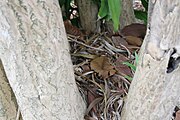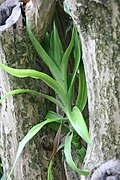Dracaena americana
| Dracaena americana | |
|---|---|

| |
| Location taken:Fairchild Tropical Botanic Garden, Miami | |
| Scientific classification | |
| Kingdom: | Plantae |
| Clade: | Tracheophytes |
| Clade: | Angiosperms |
| Clade: | Monocots |
| Order: | Asparagales |
| Family: | Asparagaceae |
| Subfamily: | Nolinoideae |
| Genus: | Dracaena |
| Species: | D. americana
|
| Binomial name | |
| Dracaena americana | |
| Synonyms[3] | |
| |
Dracaena americana, the Central American dragon tree or candlewood,[4] is a neotropical tree in the genus Dracaena, native to southern Mexico, Guatemala, Panama, Honduras, Belize, Costa Rica, and Colombia.[5] It is one of only two Dracaena species native to the Americas, the other being Dracaena cubensis.[6]
Description
[edit]Dracaena americana reaches a typical maximum height of 12 meters with a multi-stem habit; newer stem growth exhibits leaf scars, whereas older growth exhibits an exfoliating bark. The bright green straplike leaves are soft, up to 35 cm long and 2.5 cm wide, and are borne along the length of the stems, rather than the tufted habit typical of Dracaena. While capable of attaining an arborescent form up to 18 m, in drier or more open areas D. americana is more typically a prostrate understory shrub. D. americana flowers in spring with a creamy white paniculate inflorescence 20–30 cm long, followed by yellow or red fruit in fall.[6]
Taxonomy
[edit]As of 2022, Plants of the World Online treats Dracaena americana as a synonym of Dracaena ghiesbreghtii, based on an earlier publication from the Royal Horticultural Society.[7]
Distribution and habitat
[edit]With a wide distribution primarily in the humid tropical rainforest of Central America and southern Mexico, Dracaena americana is notable for its broad elevational range from sea level to 1,900 meters in the Colombian Andes.[6] It has also been introduced to Ecuador.[5] D. americana is usually found as isolated plants growing in rendzina soils, in areas that receive more than 1,500 mm of rainfall.[6]
D. americana has been cultivated as an ornamental plant since the 19th century.[7]
Ecology
[edit]The fruit is sweet and is eaten by a variety of animals, including birds[6] and the Yucatán black howler monkey.[4] It is therefore likely that animals play an important role in seed dispersal.[6]
Gallery
[edit]-
Detail of exfoliating bark
-
Inflorescence with clusters of small creamy white flowers
-
Base of trunk
-
Detail of inflorescence, showing paniculate form
-
Dracaena americana exhibiting multi-stemmed habit
-
Younger growth contrasted against older stems
References
[edit]- ^ Botanic Gardens Conservation International (BGCI) & IUCN SSC Global Tree Specialist Group (2019). "Dracaena americana". IUCN Red List of Threatened Species. 2019: e.T38915A146976116. doi:10.2305/IUCN.UK.2019-2.RLTS.T38915A146976116.en. Retrieved 18 July 2024.
- ^ "Dracaena americana", WFO (2023): Dracaena americana Donn.Sm, World Flora Online, retrieved 2023-04-21
- ^ "Dracaena ghiesbreghtii", Dracaena ghiesbreghtii W.Bull ex J.J.Blandy, Plants of the World Online, retrieved 2023-04-21
- ^ a b Trolliet, Franck (2010). "Appendix 2. List of the 42 species of plants found in quadrats and in howlers diet in Monkey River, Belize". Ecology of the Belizean black howler monkey (Alouatta pigra): a comparison between two populations living in a riparian forest and on coastal limestone hills (Msc). ULiège – Université de Liège. hdl:2268/154280. Retrieved 2023-04-21.
- ^ a b "Dracaena ghiesbreghtii – Other data", Dracaena ghiesbreghtii W.Bull ex J.J.Blandy, Plants of the World Online, retrieved 2023-04-21
- ^ a b c d e f ZONA, Scott; ÁLVAREZ DE ZAYAS, Alberto; ORELLANA, Roger; OVIEDO, Ramona; JESTROW, Brett; FRANCISCO-ORTEGA, Javier (December 2014). "Dracaena L. (Asparagaceae) in the New World: Its History and Botany". Vieraea. 42. La Laguna, Santa Cruz de Tenerife: 219–240. doi:10.31939/vieraea.2014.42.15. ISSN 0210-945X. Retrieved 21 April 2023.
- ^ a b "ghiesbreghtii". Proceedings of the Royal Horticultural Society London. 2. Missouri Botanical Garden: 365. 1862. Retrieved 23 April 2023.







